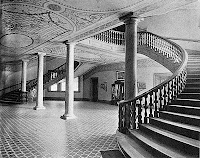Did you know that as of 2005 countries such as China, Thailand, El Salvador, Turkey, and Vietnam had no laws protecting psychiatric patients? In total 25 percent of countries in the world don't offer any sort of legal protection guaranteeing the humane treatment of people with psychiatric patients.
Eugene Richards did a photo essay of the conditions some individuals face around the world who have mental illnesses. The people that Eugene document truly represent some of the most disenfranchised, lost, and forgotten people in the world.
Why am I writing about this today? In part it's because I'm fascinated. I'm fascinated how madness/mental illness has been depicted. I'm fascinated how those depictions have both changed and not changed.
 More importantly, today I'm writing about this because I think it's important to be reminded every now and again of those in our world that are hurt, lost, and forgotten. It's becoming increasingly easier to insulate ourselves from things we don't want to know about: the right has news programs that present the view from the right, the left has news shows that present the view from the left. Our friends list on social networking sites are generally populated by people who think like us. We readily agree and support those who think like us, argue in a polarized way with those who don't, and close our minds to that which is different.
More importantly, today I'm writing about this because I think it's important to be reminded every now and again of those in our world that are hurt, lost, and forgotten. It's becoming increasingly easier to insulate ourselves from things we don't want to know about: the right has news programs that present the view from the right, the left has news shows that present the view from the left. Our friends list on social networking sites are generally populated by people who think like us. We readily agree and support those who think like us, argue in a polarized way with those who don't, and close our minds to that which is different.
Every now and again, like when I came across this photo essay, I see something that stretches me--something that makes me think about things that I would rather not. In this era when so many say we can't afford to care for those who are most vulnerable, I think it's important to see what happens when we don't care for those who are most vulnerable. I think it's important for us to see what we don't want to see.
What don't you want to see? Can you find a way to look at it today?
Eugene Richards did a photo essay of the conditions some individuals face around the world who have mental illnesses. The people that Eugene document truly represent some of the most disenfranchised, lost, and forgotten people in the world.
Why am I writing about this today? In part it's because I'm fascinated. I'm fascinated how madness/mental illness has been depicted. I'm fascinated how those depictions have both changed and not changed.
 More importantly, today I'm writing about this because I think it's important to be reminded every now and again of those in our world that are hurt, lost, and forgotten. It's becoming increasingly easier to insulate ourselves from things we don't want to know about: the right has news programs that present the view from the right, the left has news shows that present the view from the left. Our friends list on social networking sites are generally populated by people who think like us. We readily agree and support those who think like us, argue in a polarized way with those who don't, and close our minds to that which is different.
More importantly, today I'm writing about this because I think it's important to be reminded every now and again of those in our world that are hurt, lost, and forgotten. It's becoming increasingly easier to insulate ourselves from things we don't want to know about: the right has news programs that present the view from the right, the left has news shows that present the view from the left. Our friends list on social networking sites are generally populated by people who think like us. We readily agree and support those who think like us, argue in a polarized way with those who don't, and close our minds to that which is different.Every now and again, like when I came across this photo essay, I see something that stretches me--something that makes me think about things that I would rather not. In this era when so many say we can't afford to care for those who are most vulnerable, I think it's important to see what happens when we don't care for those who are most vulnerable. I think it's important for us to see what we don't want to see.
What don't you want to see? Can you find a way to look at it today?


















